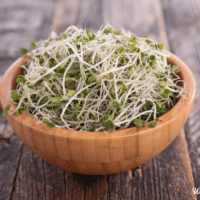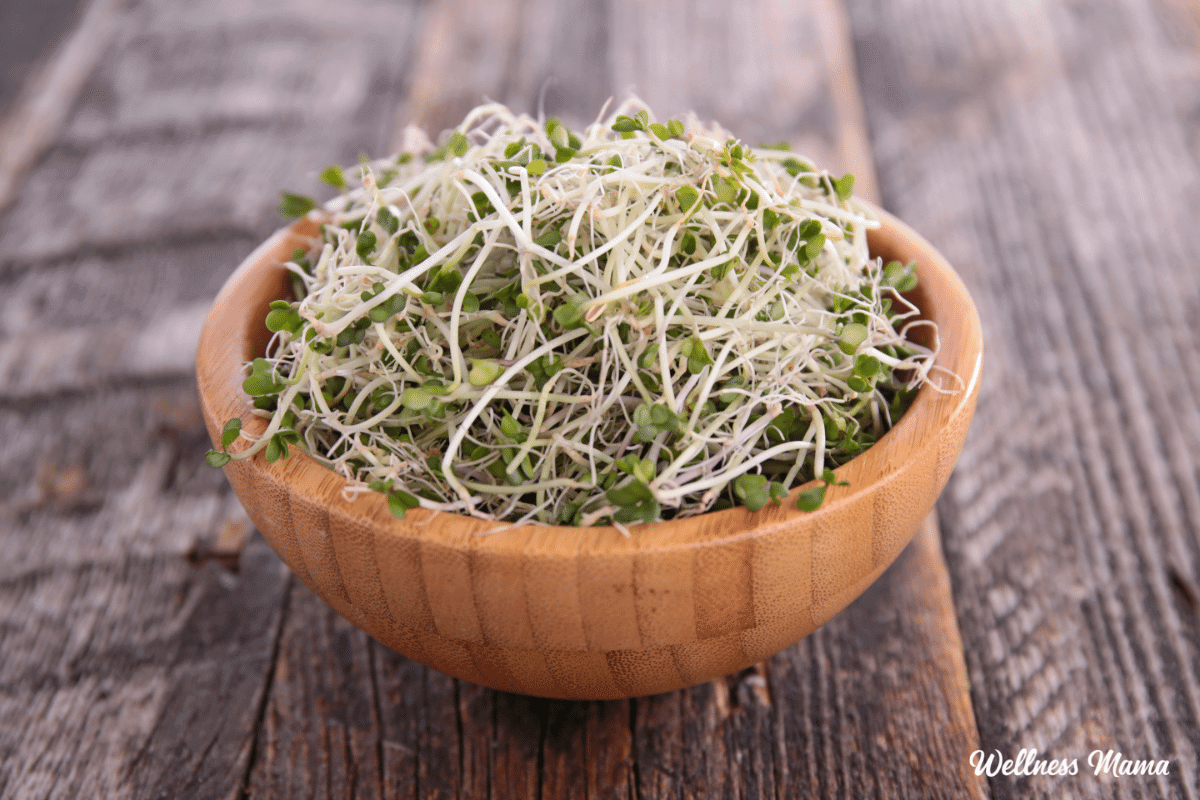If you’ve ever heard of sulforaphane you’ve probably heard about broccoli sprouts. Sulforaphane is a powerful compound with a myriad of health benefits. And it’s why broccoli sprouts are one of the best health foods on the planet.
In the springtime and early summer, our thoughts tend to turn to gardening, farmers’ markets, and fresh produce. But you don’t have to have a plot or pot of your own to grow these microgreens. All you really need is a mason jar on your kitchen counter. While your countertop garden might be small, the health benefits are not.
If you’re unfamiliar with sulforaphane, let me provide a case for why these humble sprouts should be growing in all our kitchens.
Broccoli Sprouts = High in Sulforaphane
Broccoli sprouts are an incredibly rich source of sulforaphane. I wrote an entire ode to sulforaphane but the short version is that this plant compound:
- Releases antioxidant enzymes that may protect against cancer
- Benefits the heart and protects against cardiovascular disease
- Protects the brain against disease
- Increases glutathione
- Supports natural detoxification by increasing a compound called Nrf2
Sulforaphane supports every organ system in the body in one way or another. You can easily create your own local source by growing sprouts in your kitchen. One of the first things my thyroid doctor recommended after my Hashimotos diagnosis? Eat raw broccoli sprouts daily for their sulforaphane.
Now, if you’re already ruling them out, thinking they must taste terrible, hold on a moment. Surprisingly, the sprouts don’t taste like full-grown broccoli plants. Some people say they’re spicy, like radishes, while others report they don’t notice any taste at all. However, it likely depends on how much you’re using at a time. And if you blend large amounts in a smoothie, it may release more of the flavor.
Give them a try, and if you decide they aren’t for you, there is also a great supplement option. Read on!
Why Not Just Eat Broccoli?
Cruciferous vegetables have many benefits. Researchers find that eating them raw a few times a week reduces cancer risk by 40% or more. But when it comes to sulforaphane, full-grown broccoli doesn’t come close to power-packed fresh sprouts. Three to four day old broccoli sprouts have up to 100 times the amount of sulforaphane as mature broccoli. This is because the sprouting process increases the bioavailability of nutrients, making broccoli sprouts a superfood.
On top of that, cooking destroys sulforaphane. So unless you want to chow down on several pounds of raw broccoli a day, you likely won’t get much (if any) sulforaphane. Yet, cooked broccoli, and other cruciferous vegetables, are still healthy for many other reasons. Even if they aren’t as high in sulforaphane.
Biomedical scientist Dr. Rhonda Patrick offers a tip to increase sulforaphane in cooked veggies. She recommends sprinkling them with dried mustard seed powder. Mustard seed replaces an enzyme needed for sulforaphane production but that’s destroyed in cooking.
Reasons to Grow Your Own Sprouts
Hopefully, now you’re big fans of broccoli sprouts and understand why they should be a regular part of a healthy diet. Let’s talk about why we should grow them ourselves.
Thanks to researchers like Dr. Patrick, news has spread about broccoli sprouts’ benefits. I’ve seen broccoli sprouts in many stores, including all three of our local grocery stores. But these store-bought sprouts are expensive and we can’t really know how fresh they are. Remember, sulforaphane content spikes on days 3-4 after the seed sprouts. Store-bought sprouts are likely much older than this.
Save Money by Growing Your Own
Store-bought sprouts are also really expensive compared to growing your own. In fact, you’ll spend up to 10x as much! Sprouts from the store can run $2-5 an ounce, but you can grow them at home for $0.60 an ounce. Even less if you buy broccoli seeds in bulk like I do).
With basic equipment, you can grow 15-16 pounds of broccoli sprouts per pound of broccoli seeds. To put this in perspective, a 3-ounce container of sprouts is $6 at my local store. That ends up being about $32 a pound for sprouts. An entire pound of seeds costs less than that (and much less if you buy in bulk). In fact, I buy 5 pounds of broccoli seeds for $50 and grow up to 80 pounds of broccoli seeds for that, making them $0.62 a pound.
Plus, It is Soooo Easy
Some vegetables are worth buying because they’re too time intensive to grow. Or they take up too much room in the garden. Cabbage, celery, fennel, and some lettuces are all on this list. Organic broccoli sprouts are not. They’re almost foolproof to grow, ready to eat in days, and healthier than almost any other vegetable we can grow.
No Time/Don’t Like Sprouts?
Many sulforaphane supplements aren’t well absorbed by the body since it’s difficult to stabilize. The one exception I make is for this brand. They’ve developed a unique new process for naturally stabilizing sulforaphane. This is a great option if you don’t have the time or desire to harvest and juice broccoli sprouts every day. We take it when we’re busy or traveling. (They have a kids’ version too!)

How to Grow Broccoli Sprouts
Servings
Equipment
- Sprouting jar holders or a glass bowl that can hold up the jar
- Seed tray optional, to hold jars
Ingredients
- 2 TBSP broccoli seeds I buy in bulk
- filtered water
Instructions
- Place the broccoli sprouting seeds in a wide-mouth mason jar and cover with a few inches of filtered water.
- Put a sprouting lid on and place the jar in a slightly warm, dark place away from direct sunlight for 8-12 hours.
- The next day (or at least 8 hours later), drain off the water and rinse with fresh water.
- Rest the mason jar upside down at an angle on a sprouting jar holder or inside a bowl so any remaining water can drain. Continue to keep the jar in a slightly warm but mostly dark place during this time.
- Rinse the sprouts 2-3 times a day and place them back on the jar holder or bowl after each rinse. I rinse at meal times so I remember. After a few days, all the seeds should start to break open and grow.
- Keep up with the rinsing and keep the seeds in a darkish place until the raw sprouts are about an inch long. At this point they can tolerate some indirect sunlight or low light exposure.
- Eat the seeds once you see some dark green leaves, usually 3-4 days after they start to sprout.
Nutrition
Notes
The Best Place to Grow Broccoli Sprouts
I’ve tried various places and find this works best to place the jar on the counter above my dishwasher right before I go to bed. I cover the jar with a towel and start the dishwasher so a small amount of heat comes through the counter and helps the seeds sprout more quickly. That said, it also works to leave the jar anywhere on the counter or place it inside a cabinet at room temperature.
After a while, the sprouting just becomes part of the natural rhythm of the day and week.
To Store the Broccoli Sprouts
Wait at least 12 hours from the last rinse so all remaining moisture can drain off. Replace the sprouting lid with a regular mason jar lid or transfer it to an airtight container. Place in the refrigerator and store for up to a few weeks (though I recommend using them as quickly as possible).
How to Boost Sulforaphane in Broccoli Sprouts
These adorable sprouts are already one of the best sources of sulforaphane. But, if you want to be an overachiever, there are a couple of ways to increase the sulforaphane content before you eat them. The method I’m about to recommend is counterintuitive … heat them up.
I know, I know, I already said not to heat them above 158 degrees. But it turns out heating them to just below that actually increases sulforaphane. Heating to an exact temperature may also deactivate sulforaphane nitriles, which aren’t as beneficial. If we hit an exact temperature of around 158 degrees Fahrenheit, it deactivates the sulforaphane nitrile and not the myrosinase needed for optimal sulforaphane.
Dr. Patrick explains the sweet spot is heating to exactly 158 degrees Farenheight for 10 minutes. See her process in the video below. At her suggestion, I heat water and use a digital thermometer that beeps when it reaches temperature. As soon as the water hits 158, I pour it into a jar with the sprouts and set a timer for 10 minutes. Then, I let it cool and blend it in a blender.
Fair warning: a broccoli sprout smoothie is an acquired taste. I do it because it’s nutritious, but as you’d expect with a sulfur-containing food, it has a strong taste.
You don’t have to drink it straight up. You could also take a small handful and add them to your favorite fruit smoothie or juice. In small amounts, the flavor shouldn’t be too intense.
Have you ever grown broccoli sprouts? If so, what are your favorite ways to include them in your diet?
This article was medically reviewed by Dr. Scott Soerries, MD, Family Physician and Medical Director of SteadyMD. As always, this is not personal medical advice and we recommend that you talk with your doctor.
Have you ever grown broccoli sprouts? Will you join the sulforaphane fan club and start now? If you already grow broccoli sprouts, tag me (@wellnessmama) in your photos on social media so I can see!




Leave a Reply